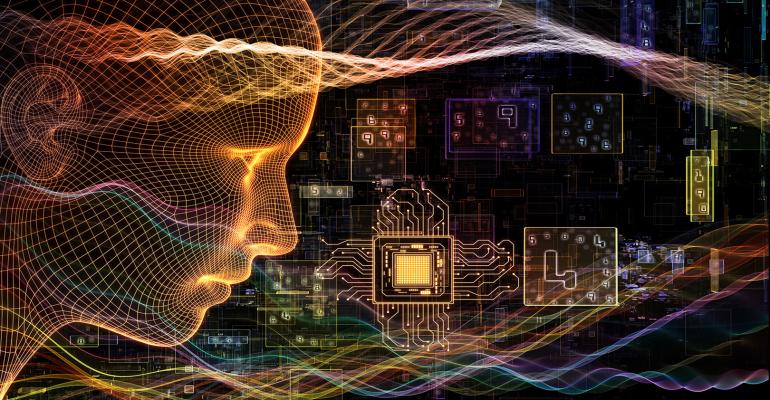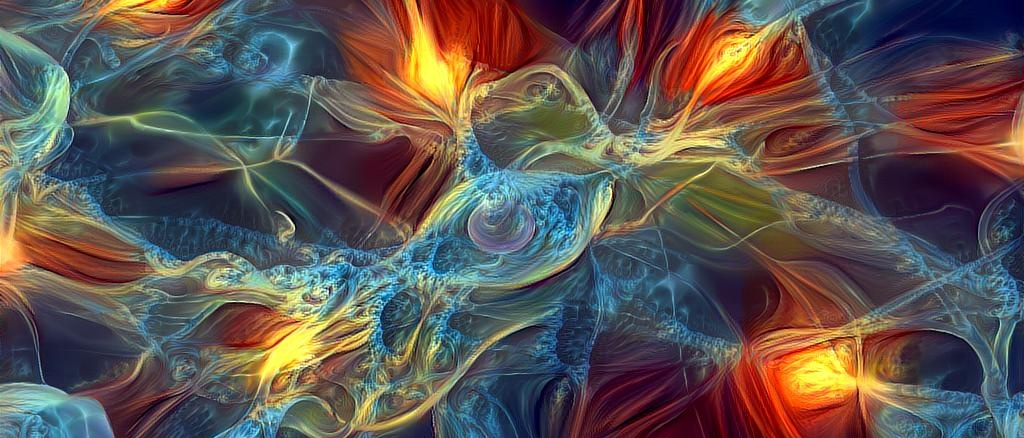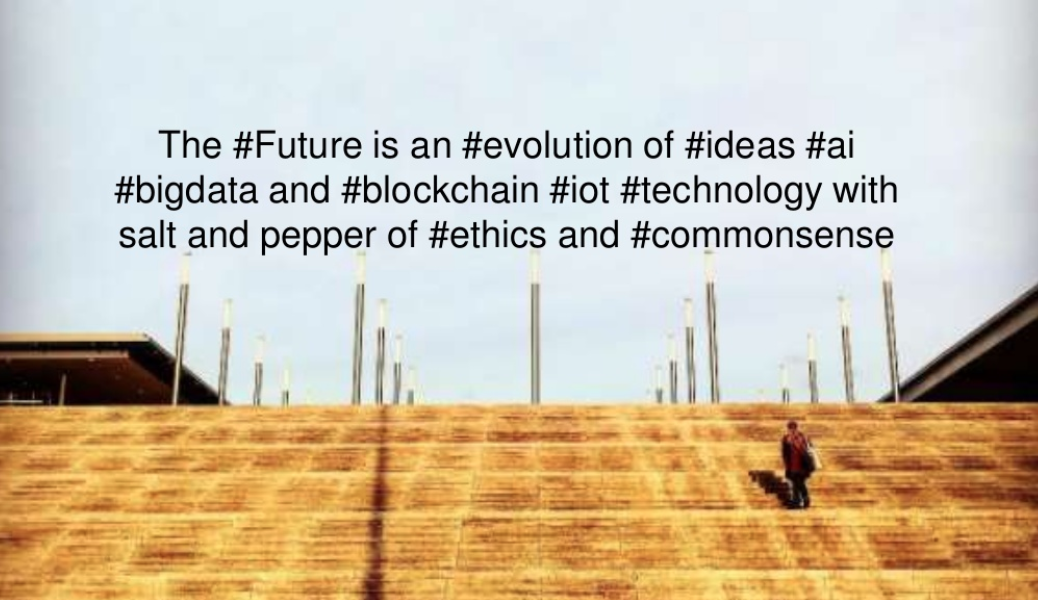
An article in two parts reflecting on the transformational power of blockchain and AI joined together. The first part covered blockchain, whereas the second addresses AI and what can be expected from the conjugation of both.
“In the brain, you have connections between the neurons called synapses, and they can change. All your knowledge is stored in those synapses. You have about 1,000-trillion synapses – 10 to the 15, it’s a very big number.” Geoffrey Hinton
The older generation might remember the early computers… These were mainframes computers that performed calculations that no one but universities, research labs engaged in scientific calculations or Governments, had the need to do. Then, time passed, and computers became smaller… and cheaper! Step by step, we began relying on computers to do more and more things. Now, they are indispensable tools in our lives. We all have them, in our pockets, and most have the capacity and potency of the one used by the US Government in the fifties. But have we reached a plateau? Definitely not! Recent developments in AI, and quantum computing are now promising to expand even more the computational capacity. What we might be able to do in the future with it will be incredible.
AI and the shift to a new radical (quantum) computing architecture
Defining Artificial Intelligence is hard, as it can be seen through different iterations, concepts and variations. Taken to its straightforward definition, artificial Intelligence is the capability of a machine to imitate intelligent human behaviour. We don’t need to think of complicated robots to understand or picture AI. All things that augment artificially machine intelligence, are part of AI. How our phones work, is perfect to illustrate how AI advances and empowers all areas of society. smartphones have been developing through a whole set of operations of algorithms. These operations make them increasingly autonomous machines that are designed to be self sufficient, and learn without the help of human intervention and guidance.
The impact of AI in the shaping of the upcoming world promises to surpass our most wild imagination. and a way to expand on this, is to hold in the back of our minds, some general themes about AI, such as the following:
- AI Technology and patterns of code: can these be seen as a philosophy ?
- What has been the evolution of humanity versus technology?
- AI promotes hybrid systems: how to manage parallel realities?
- What will be the evolution of ethics in a time of AI code manipulations?
- Is machine learning and deep learning as an extension of human perception ?
- Patterns and macro patterns
- Swarm intelligence as a symbiotic system of operations
- Will the movement towards singularity, promote transhumanism or is this the path to a terminator nightmare?
Some examples of how AI is paving the way to a new world, are two interesting recent evolutions, the widespread adoption of a new type of computing, quantum computing and the recent invention of neuromorphic chips.
Quantum computing, which will most likely replace quantum computing, is a type of computing using quantum-mechanical phenomena. A quantum computer is a device that performs quantum computing. This type of computing is different from binary digital electronic computers, which are based on transistors. Whereas common digital computing requires that the data be encoded into binary digits (bits), each of which is always in one of two definite states (0 or 1), quantum computation uses quantum bits, which can be in superpositions of states. Quantum computing is still in its infancy, but their promise is to create incredibly large computing spaces. These computers, would enable us to solve in seconds problems that would take traditional computers millennia to crack. An example of the possible applications of quantum computers, are for example, massive simulations – like the ones done by physicists at CERN’s Hadron collider. Being able to do this and other even more complex calculations, will fundamentally alter our ability to understand the physical world.
Another interesting innovation pertaining to the AI field with revolutionary potential, is neuromorphic computing. Neuromorphic computing is based in neuromorphic chips. These are named so, because they are modelled on the way biological brains works. As such, they are designed to access and interpret sensory data such as images and sound and to respond to changes in that data, in an organic adaptable way, that is not specifically programmed. Neuromorphic chips hold the potential of accelerating the speed of progress in artificial intelligence and also originate machines that are closer to the human ways of being.
Neuromorphic chips don’t require a lot of energy, and can be used in tasks of artificial intelligence, thus potentiating the expansion of the Internet of Things. They will also be more able to understand and interact with the world organically, in humanlike ways.

How will these innovations impact the evolution of business? I would say that in a decade we will see the first possible business applications of neuromorphic chips and quantum computing. Just imagine quantum computing analysing in a few seconds huge amounts of data pertaining to consumer behaviours! This, will happen hand to hand with the effect of neuromorphic chips. As these expand, more sensors will be created that provide massive amounts of information, which will be analysed by quantum computers. It is the conjugation of both that will enable us to decode patterns of behaviour, that will inform novel decisions on what are the needs of society. Inevitably, these will lead towards an expansion into novel business and economic frameworks, aiming to answer the needs of future societies.
There is a proverbial fear of the machine, being awakened in this evolution. Remember Hal 9000, from the iconic film “2001: A Space Odyssey”? Over the course of the voyage, Hal, the calm and funny computer, was gaining a life and will of his own, which was leading into wanting to kill the astronauts. What is happening now, may well be the coming of age of all those science fiction myths and visions, of autonomous intelligent brain-like machines, gaining an independent intelligence and life, as they become indispensable to our daily live operations. Hopefully, they will not go the path of the terminator, as Hall did…
AI will be the new driver leading us to default universal UI
Taking a step further into futurology, let’s look at a world where AI will drive us into totally novel user Interfaces… where devices are not needed anymore… Remember the technology of the film Minority Report ? its even more sophisticated version, is coming into life!
It’s been 30 years, since Don Norman published his seminal book, The Design of Everyday Things in 1988. The book, explored the idea of how and why some products satisfied people while others only frustrate them. The key feature for satisfaction was usability, and this set the ground for what would become the user-centered design movement.
The digital age, which has been very affected by the user-centered design movement, has evolved through various kinds of interfaces, and these, have eased our life and enabled our mobility. The older readers, will certainly remember the time of plain keyboards, and then the shift to mouses. From mouses we moved to touch, and now, we are giving the first steps into using voice and motion to interact with devices. Some experiments with biometrics also explore ways to use our facial and biological characteristics to order technology to do what we want it to do. We never think about this, but the seamless operations we make with our phones and devices, are also the result and part of Artificial intelligence. AI is shaping the new user interfaces, which are leading us to a world, where devices don’t exist anymore!
What seems to become an important area of research, in coming years, will be to to design conversational intelligence, with a high degree of complexity, that enables us to understand how our commands and queries relate to previous turns and the overall context. As there is an evolution towards a seamlessly integration of multiple interfaces (touch, voice and bro systems) our experience, driven and conditioned to the data, will be less dependent on visible devices and interfaces. Quantum computing and neuromorphic chips are the two technologies that will enable the expansion of these invisible user interfaces! In a feedback loop, as UI advances and becomes more pervasive, the AI capabilities will increase as well, and our user experience will be even more refined.
Blockchain + AI : The new holistic layer building blocks of the new DNA
“The blockchain is an incorruptible digital ledger of economic transactions that can be programmed to record not just financial transactions but virtually everything of value.”Don & Alex Tapscott, authors Blockchain Revolution (2016)
“Blockchain solves the problem of manipulation. When I speak about it in the West, people say they trust Google, Facebook, or their banks. But the rest of the world doesn’t trust organizations and corporations that much — I mean Africa, India, the Eastern Europe, or Russia. It’s not about the places where people are really rich. Blockchain’s opportunities are the highest in the countries that haven’t reached that level yet.” Vitalik Buterin, inventor of Ethereum
“Online identity and reputation will be decentralized. We will own the data that belongs to us.” William Mougayar, author The Business Blockchain: Promise, Practice, and Application of the Next Internet Technology (2016)
“Just consider this: control of a currency is one of the most powerful tool a government wields; ask anybody in Ireland, Portugal, Greece, or Cyprus who lived through those countries’ recent financial crises. Bitcoin promises to take at least some of that power away from governments and hand it to people. That alone augurs significant political, cultural, and economic clashes.” Paul Vigna, The Age of Cryptocurrency: How Bitcoin and Digital Money Are Challenging the Global Economic Order
“Cryptocurrency Protocols Are Like Onions… One common design philosophy among many cryptocurrency 2.0 protocols is the idea that, just like the internet, cryptocurrency design would work best if protocols split off into different layers. Under this strain of thought, Bitcoin is to be thought of as a sort of TCP/IP of the cryptocurrency ecosystem, and other next-generation protocols can be built on top of Bitcoin much like we have SMTP for email, HTTP for webpages and XMPP for chat all on top of TCP as a common underlying data layer.” Vitalik Buterin

Blockchain is not independent of AI, and it is actually the combination of blockchain and AI, that is revolutionary. Machine learning, deep learning and its evolutionary ramifications together with distributed technologies will provide the needed change for more innovation, which will open us to unimaginable possibilities.
How to Define True Sustainable Innovation in a AI Blockchain Driven New fast Disruptive World?
“In science, you can say things that seem crazy, but in the long run they can turn out to be right. We can get really good evidence, and in the end the community will come around.” Geoffrey Hinton
“I refuse to say anything beyond five years because I don’t think we can see much beyond five years.” Geoffrey Hinton
How to fuel all these transformational technologies ? The speed at which blockchain is being adopted has been fast but it needs now to expand to various layers in society, financial industry, business, administration. Pundits, technologists and academics, enthusiastically state that blockchain will replace our existing foundational technological infrastructure in one decade and two and that there will be wide-ranging implications. I subscribe tpthat view but alert to its seven different layers that I highlighted in the beginning of this text.
In order for this to happen, there is a need for a lot of research, the set up of a novel infrastructure and funding, which explains the recent ICO phenomena, where billions were raised with the launching of all kinds of different projects and tokens. That flow of money, being allocated to blockchain tech companies and startups, is enabling not only the speeding up of expansion of blockchain and AI tech, but also its scalability, interoperability and functionality. These technologies will then, finally, be able to go mainstream.
Now the question is if it’s going to be one solution, or various solutions. The sector is really competitive, and its important to keep being faithful to its principles, of being distributed!
True and sustainable innovation, by definition, is disruptive. The new turn happening, with the evolution of blockchain and artificial intelligence will bring even more disruption and it will open us to holistic deep levels of change, technological, social and financial. we need to be prepared for the new evolution, understand it, act on it and start to embrace it!
Blockchain Plus AI The Present Future of Tech Part 1
Sources and personalities:
Geoffrey Hinton, https://en.wikipedia.org/wiki/Geoffrey_Hinton
Hello World Canada: The Rise of AI, https://www.bloomberg.com/news/videos/2018-05-23/hello-world-canada-the-rise-of-ai-video
Let’s Face It, Chatbots Sound Like Idiots. Here’s How We Can Change That
The Roard To Year Million,
Neuromorphic Chips,https://www.technologyreview.com/s/526506/neuromorphic-chips/
Moore’s law, http://www.wired.co.uk/article/wired-explains-moores-law
Over 50 Bitcoin and Blockchain Thoughts and Quotes You Need to Read
Unsupervised Learning: Foundations of Neural Computation (Computational Neuroscience (1999), by Geoffrey Hinton and Terrence J. Sejnowski
https://aaai.org/ojs/index.php/aimagazine/article/view/1565
Digging deeper into cryptoassets: data and visualization resources,
https://hackernoon.com/digging-deeper-into-cryptoassets-data-and-visualization-resources-8a922b62d51c
Top crypto exchanges, https://www.forbes.com/sites/sarahhansen/2018/06/20/forbes-guide-to-cryptocurrency-exchanges/

Dinis Guarda is an author, academic, influencer, serial entrepreneur, and leader in 4IR, AI, Fintech, digital transformation, and Blockchain. Dinis has created various companies such as Ztudium tech platform; founder of global digital platform directory openbusinesscouncil.org; digital transformation platform to empower, guide and index cities citiesabc.com and fashion technology platform fashionabc.org. He is also the publisher of intelligenthq.com, hedgethink.com and tradersdna.com. He has been working with the likes of UN / UNITAR, UNESCO, European Space Agency, Davos WEF, Philips, Saxo Bank, Mastercard, Barclays, and governments all over the world.
With over two decades of experience in international business, C-level positions, and digital transformation, Dinis has worked with new tech, cryptocurrencies, driven ICOs, regulation, compliance, and legal international processes, and has created a bank, and been involved in the inception of some of the top 100 digital currencies.
He creates and helps build ventures focused on global growth, 360 digital strategies, sustainable innovation, Blockchain, Fintech, AI and new emerging business models such as ICOs / tokenomics.
Dinis is the founder/CEO of ztudium that manages blocksdna / lifesdna. These products and platforms offer multiple AI P2P, fintech, blockchain, search engine and PaaS solutions in consumer wellness healthcare and life style with a global team of experts and universities.
He is the founder of coinsdna a new swiss regulated, Swiss based, institutional grade token and cryptocurrencies blockchain exchange. He is founder of DragonBloc a blockchain, AI, Fintech fund and co-founder of Freedomee project.
Dinis is the author of various books. He has published different books such “4IR AI Blockchain Fintech IoT Reinventing a Nation”, “How Businesses and Governments can Prosper with Fintech, Blockchain and AI?”, also the bigger case study and book (400 pages) “Blockchain, AI and Crypto Economics – The Next Tsunami?” last the “Tokenomics and ICOs – How to be good at the new digital world of finance / Crypto” was launched in 2018.
Some of the companies Dinis created or has been involved have reached over 1 USD billions in valuation. Dinis has advised and was responsible for some top financial organisations, 100 cryptocurrencies worldwide and Fortune 500 companies.
Dinis is involved as a strategist, board member and advisor with the payments, lifestyle, blockchain reward community app Glance technologies, for whom he built the blockchain messaging / payment / loyalty software Blockimpact, the seminal Hyperloop Transportations project, Kora, and blockchain cybersecurity Privus.
He is listed in various global fintech, blockchain, AI, social media industry top lists as an influencer in position top 10/20 within 100 rankings: such as Top People In Blockchain | Cointelegraph https://top.cointelegraph.com/ and https://cryptoweekly.co/100/ .
Between 2014 and 2015 he was involved in creating a fabbanking.com a digital bank between Asia and Africa as Chief Commercial Officer and Marketing Officer responsible for all legal, tech and business development. Between 2009 and 2010 he was the founder of one of the world first fintech, social trading platforms tradingfloor.com for Saxo Bank.
He is a shareholder of the fintech social money transfer app Moneymailme and math edutech gamification children’s app Gozoa.
He has been a lecturer at Copenhagen Business School, Groupe INSEEC/Monaco University and other leading world universities.











